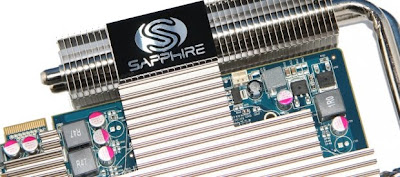When you're talking about budget gaming graphics cards then you really can't spend less than £75 if you want to get anywhere near playable frame rates. At the bottom of this particular pile then is AMD's Radeon HD 5670, here represented by Sapphire's passively-cooled Ultimate edition.
The Radeon HD 5xxx series of cards are getting a bit long in the tooth these days; this particular GPU was introduced way back in the small hours of January 2010. It's still almost a relevant card these days though, offering close to playable gaming speeds in a tiny, no nonsense package.
The passive cooler sitting atop this Ultimate edition of the HD 5670 makes it a perfect match for the living room machine where silence is more preferable to out and out performance.
This is a good thing as the straight line performance of the HD 5670 is looking a little out of date now. but we'll come to that in a second.
Hot, hot, hot
The trade of f with the passive cooler is heat dissipation, and without a fan cooling down the fins of the heatsink the GPU runs up to around 80°C under load. Not only will that affect the GPU over time if it's continually stressed, but will also increase the ambient heat of the case, and in smaller form factor living room machines that's not a hugely desirable quality.
The fact that it's a standard height card loo means it's not ideal for the smaller cases, but when you're getting into the realm of half-height cards you're not going to be getting anywhere near gaming performance out of them. So this is a fairly decent compromise then.
Coming back to the performance angle though and inevitably this cheapest card on test comes in at the bottom almost across the board. In the modern titles it is off the pace at the modest resolution of 1,680 x 1,050, though all our benchmarks were taken on high settings with 4x anti-aliasing switched on. Drop the settings and resolution down a couple of notches and you could get some decent gaming done.
Looking especially at the venerable For Cry 2 score of 31 f ps and it's clear older titles will happily run at impressive frame rates on this hardware. So as long as you're not hoping to play the latest games on a machine with the HD 5670 at its heart, it's not a bad choice for the cash you're spending.
You also don't have to worry about power requirements, as all the juice it needs to run comes from the PCI-e bus alone. That means no worrying about having the right connectors on your PSU.
So it's an okay performer on the older games and runs silently while doing it. The real problem is at £75 for such an old card it's not great value for money, especially when you consider much more relevant cards can be picked up for less than a tenner extra.
The Radeon HD 5xxx series of cards are getting a bit long in the tooth these days; this particular GPU was introduced way back in the small hours of January 2010. It's still almost a relevant card these days though, offering close to playable gaming speeds in a tiny, no nonsense package.
The passive cooler sitting atop this Ultimate edition of the HD 5670 makes it a perfect match for the living room machine where silence is more preferable to out and out performance.
This is a good thing as the straight line performance of the HD 5670 is looking a little out of date now. but we'll come to that in a second.
Hot, hot, hot
The trade of f with the passive cooler is heat dissipation, and without a fan cooling down the fins of the heatsink the GPU runs up to around 80°C under load. Not only will that affect the GPU over time if it's continually stressed, but will also increase the ambient heat of the case, and in smaller form factor living room machines that's not a hugely desirable quality.
The fact that it's a standard height card loo means it's not ideal for the smaller cases, but when you're getting into the realm of half-height cards you're not going to be getting anywhere near gaming performance out of them. So this is a fairly decent compromise then.
Coming back to the performance angle though and inevitably this cheapest card on test comes in at the bottom almost across the board. In the modern titles it is off the pace at the modest resolution of 1,680 x 1,050, though all our benchmarks were taken on high settings with 4x anti-aliasing switched on. Drop the settings and resolution down a couple of notches and you could get some decent gaming done.
Looking especially at the venerable For Cry 2 score of 31 f ps and it's clear older titles will happily run at impressive frame rates on this hardware. So as long as you're not hoping to play the latest games on a machine with the HD 5670 at its heart, it's not a bad choice for the cash you're spending.
You also don't have to worry about power requirements, as all the juice it needs to run comes from the PCI-e bus alone. That means no worrying about having the right connectors on your PSU.
So it's an okay performer on the older games and runs silently while doing it. The real problem is at £75 for such an old card it's not great value for money, especially when you consider much more relevant cards can be picked up for less than a tenner extra.


Conversion Conversion Emoticon Emoticon